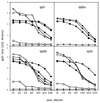Intranasal administration of synthetic recombinant peptide-based vaccine protects mice from infection by Schistosoma mansoni
- PMID: 10456875
- PMCID: PMC96753
- DOI: 10.1128/IAI.67.9.4360-4366.1999
Intranasal administration of synthetic recombinant peptide-based vaccine protects mice from infection by Schistosoma mansoni
Abstract
Schistosomiasis is the cause of a chronic debilitating disease which accounts for significant mortality and morbidity every year, especially in tropical and subtropical areas. An epitope derived from the protective surface protein 9B-Ag of Schistosoma mansoni, designated 9B peptide-1, was previously showed to be protective in mice when conjugated to bovine serum albumin and administered subcutaneously in complete Freund's adjuvant. In this work, this protective peptide was expressed in the flagellin of a Salmonella vaccine strain, and the isolated recombinant flagella were used for immunization of mice. Since during the invasion of the parasite into the host the schistosomula migrate first to the lungs, the intranasal route of administration was employed in order to halt the parasite at an early stage of the infection. Such intranasal immunization with this peptide expressed in flagellin, without the addition of adjuvants, resulted in a significant humoral response and also led to protection against challenge infection, manifested as a reduction of the worm burden by an average of 42%.
Figures







Similar articles
-
Synthesis and characterization of a protective peptide-based vaccine against Schistosoma mansoni.Infect Immun. 1998 Sep;66(9):4526-30. doi: 10.1128/IAI.66.9.4526-4530.1998. Infect Immun. 1998. PMID: 9712813 Free PMC article.
-
Schistosoma mansoni gene GP22 encodes the tegumental antigen sm25: (1) antibodies to a predicted B-cell epitope of Sm25 cross-react with other candidate vaccine worm antigens; (2) characterization of a recombinant product containing tandem-repeats of this peptide as a vaccine.Parasite Immunol. 2000 Aug;22(8):381-95. doi: 10.1046/j.1365-3024.2000.00316.x. Parasite Immunol. 2000. PMID: 10972845
-
Evaluation of recombinant protein r140, a polypeptide segment of tegumental glycoprotein Sm25, as a defined antigen vaccine against Schistosoma mansoni.Parasite Immunol. 1997 Nov;19(11):515-29. doi: 10.1046/j.1365-3024.1997.d01-160.x. Parasite Immunol. 1997. PMID: 9427998
-
A DNA-prime/protein-boost vaccination regimen enhances Th2 immune responses but not protection following Schistosoma mansoni infection.Parasite Immunol. 2003 Aug-Sep;25(8-9):429-37. doi: 10.1111/j.1365-3024.2003.00651.x. Parasite Immunol. 2003. PMID: 14651590
-
Protective antigens in experimental schistosomiasis.Acta Trop Suppl. 1987 Jun;12:63-9. Acta Trop Suppl. 1987. PMID: 2442987 Review. No abstract available.
Cited by
-
Protection against multiple influenza A virus strains induced by candidate recombinant vaccine based on heterologous M2e peptides linked to flagellin.PLoS One. 2015 Mar 23;10(3):e0119520. doi: 10.1371/journal.pone.0119520. eCollection 2015. PLoS One. 2015. PMID: 25799221 Free PMC article.
-
Enhanced antigen processing of flagellin fusion proteins promotes the antigen-specific CD8+ T cell response independently of TLR5 and MyD88.J Immunol. 2011 Jun 1;186(11):6255-62. doi: 10.4049/jimmunol.1001855. Epub 2011 Apr 22. J Immunol. 2011. PMID: 21515787 Free PMC article.
-
Serological assessment of synthetic peptides of Campylobacter jejuni NCTC11168 FlaA protein using antibodies against multiple serotypes.Med Microbiol Immunol. 2008 Mar;197(1):45-53. doi: 10.1007/s00430-007-0058-x. Epub 2007 Aug 18. Med Microbiol Immunol. 2008. PMID: 17704944
-
Flagellin as an adjuvant: cellular mechanisms and potential.J Immunol. 2010 Nov 15;185(10):5677-82. doi: 10.4049/jimmunol.1002156. J Immunol. 2010. PMID: 21048152 Free PMC article. Review.
-
Direct stimulation of tlr5+/+ CD11c+ cells is necessary for the adjuvant activity of flagellin.J Immunol. 2009 Jun 15;182(12):7539-47. doi: 10.4049/jimmunol.0804225. J Immunol. 2009. PMID: 19494277 Free PMC article.
References
-
- Anderson S, Shires V L, Wilson R A, Mountford A P. In the absence of IL-2, the induction of Th1-mediated protective immunity by the attenuated schistosome vaccine is impaired, revealing an alternative pathway with Th2-type characteristics. Eur J Immunol. 1998;28:2827–2838. - PubMed
-
- Arnon A, Levi R. Synthetic recombinant vaccines against viral agents. Int Arch Allergy Immunol. 1995;108:321–326. - PubMed
-
- Auriault C, Gras M H, Pierce R J, Butterworth A E, Wolowczuk I, Capron M, Ouma J H, Balloul J M, Khalife J, Neyrinck J L, et al. Antibody response of Schistosoma mansoni-infected human subjects to the recombinant P28 glutathione-S-transferase and to synthetic peptides. J Clin Microbiol. 1990;28:1918–1924. - PMC - PubMed
-
- Ben-Yedidia T, Arnon R. Design of peptide and polypeptide vaccines. Current Opin Biotechnol. 1997;8:442–448. - PubMed
-
- Ben-Yedidia T, Arnon R. Effect of pre-existing carrier immunity on the efficacy of synthetic influenza vaccine. Immunol Lett. 1998;64:9–15. - PubMed
Publication types
MeSH terms
Substances
LinkOut - more resources
Full Text Sources
Other Literature Sources

